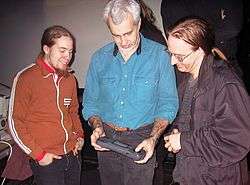Robert J. Mical
| Robert J. "RJ" Mical | |
|---|---|
 RJ Mical signing an Amiga 1200 for the 25th anniversary of the Amiga computer, 2011 | |
| Born | 26 January 1956 |
| Nationality | American |
| Occupation | Inventor |
| Website |
mical |

Robert J. "RJ" Mical (born January 26, 1956) is a pioneer and an influential figure in the video game industry. He created video games at Williams Electronics, helped invent the Amiga computer,[1][2] and co-invented the Atari Lynx and the 3DO Interactive Multiplayer with Dave Needle.[3] He was the central developer of Amiga's Intuition user interface and was well known at early Amiga gatherings. Mical was the chief architect of the Fathammer mobile game engine. From 2005 to 2011 he worked as a senior manager at Sony on the PlayStation product line. Since 2011 he has been working on software games and inventions with his own company, Arjinx. In 2012 he started working on game technology for Google.[4]
Biography
According to Mical he created his first electronic game, a tic-tac-toe player, when he was 14.
Robert J. Mical graduated in 1979 from the University of Illinois with dual degrees in Computer Science and English, plus a minor in Philosophy.[5]
From 1983 to 1984, Mical was software engineer at Williams Electronics. He worked on different projects, creating special effects, enemy intelligence, graphics, interface logic, and documentation development. He was involved in the development of the game Sinistar and notably coordinated the Star Rider project, a racing game on LaserDisc.[6]
From 1984 to 1986, Robert J. Mical worked for Amiga Corporation and then Commodore International on the development of the Amiga 1000 and later models. As software engineer, he created various development tools and the animation system software. He developed Intuition, the Amiga user interface system software.[6] He also contributed to the Amiga hardware design and helped create an early milestone software program for the computer: the Amiga Boing Demo. At the peak of his responsibilities he was appointed Director of Software. After leaving the company, he became an independent contractor, serving the Amiga community by creating development and support tools and games for a number of clients. He notably contributed to the development of Defender of the Crown (1986) from Cinemaware.
From 1987 to 1989 he became vice-president of the game technology division of Epyx, reuniting with Dave Needle (from Amiga Corp.) and their boss Dave Morse (co-founder of Amiga Computer and Crystal Dynamics). He co-developed the first color handheld console, the Lynx (known back then under the name Handy), which was later acquired by Atari Corporation. He was the co-designer of the hardware and put together a variety of software development tools including runtime libraries, a debugger, art and audio tools, plus an emulator. He also produced the six Lynx launch titles, like Blue Lightning (1989), and co-designed several of them.
From 1990 to 1995, Mical was one of the co-founders of New Technologies Group (NTG), a company established primarily to create a new game system, reuniting again with Needle and Morse. Mical co-designed the hardware and headed the creation of the system's multitasking operating system, Portfolio. The company later merged with The 3DO Company and their technology became the base of the 32-bit console 3DO Interactive Multiplayer. Mical also created a number of other systems for NTG, including a file system for medical devices.
A 1995 article in Next Generation commented "It's true that of the machines that Mical and Needle have created, only the Amiga has been a true global mass market hit ... But it's only fair to put forward the argument that this is down to the marketing of the machines rather than the quality of the product."[7]
From 1996 to 2005, Mical worked on projects in the mobile and online spaces. In 1996 and 1997, Mical was part of the creation of a joint company effort, joining Prolific and founding Glassworks, which undertaking was specialized in the development of online games. In 1998 and 1999, he worked as consultant for Rjave. In 2000 and 2001, he was vice president of software at Red Jade, a handheld console project by Ericsson. In 2001 and 2002, he was the chief architect of Fathammer, a group that provided 3D game software development and runtime technology, intended to support the creation of 3D games on mobile phones. In 2003 and 2004, Mical did independent contracting and was the vice president of software at Global VR, a company that created arcade versions of popular PC and console games.
From 2005 to 2011, he was employed by Sony Computer Entertainment to develop software components and development tools for the PlayStation 3 and PlayStation Vita. In 2008 he started publishing a weekly puzzle called the Monday Morning Tickler. Since 2011 he has worked on software games and inventions with his own company, Arjinx.[4] Currently he is exploring the entertainment and machine consciousness space for Google.
References
- ↑ Burnham (2003) p.320
- ↑ DeMaria (2003) p. 109
- ↑ Kohler (2005) p.215
- 1 2 Mical, Robert J. "Work History of RJ Mical". Retrieved 2013-02-03.
- ↑ "Mical resume on his web site". Retrieved 2008-05-20.
- 1 2 http://www.retrogamer.net/profiles/developer/r-j-mical/
- ↑ "75 Power Players: Back at the Lab...". Next Generation. Imagine Media (11): 73. November 1995.
- Burnham, Van (2003) "Supercade: A Visual History of the Videogame Age 1971-1984" ISBN 0-262-52420-1
- DeMaria and Wilson (2003) ""High Score!: The Illustrated History of Electronic Games" ISBN 0-07-223172-6
- Kohler, Chris (2005) "Retro Gaming Hacks" ISBN 0-596-00917-8
- Interviewed in 2005 Documentary Amiga Forever imdb
- Biographies of RJ allgame
- Ars technica article on the history of the amiga
External links
| Wikimedia Commons has media related to Robert J. Mical. |
- His personal web site
- Robert J. Mical's profile at MobyGames
- 100 minute talk by RJ on the making of the Amiga
- Interviews with RJ with at 1up magazine and Digital Game Developer magazine